Kurikulum Merdeka Rangkuman Materi IPA Kelas 8 Bab 5 Unsur Senyawa dan Campuran
Summary
TLDRThis educational video explores the concepts of elements, compounds, and mixtures, designed for 8th-grade students. It covers the smallest components of matter, elements, and their classification into metals, nonmetals, and metalloids. The video explains atomic structure, the periodic table, and how compounds form through chemical bonds. It also delves into different types of mixtures—solutions, suspensions, and colloids—and methods for separating them, such as filtration, evaporation, and distillation. With clear explanations and real-life examples, this video offers an accessible introduction to fundamental scientific concepts in chemistry.
Takeaways
- 😀 Elements are the smallest parts of a substance, and there are 118 known elements, divided into natural and synthetic categories.
- 😀 The periodic table is a system for organizing elements based on their properties, such as atomic structure and behavior.
- 😀 Elements can be grouped into metals, non-metals, and metalloids, each with distinct physical and chemical properties.
- 😀 Metals are good conductors of electricity and have high melting and boiling points, while non-metals do not conduct electricity and have lower melting points.
- 😀 Atomic theory suggests atoms consist of protons, neutrons, and electrons, with electrons orbiting the nucleus, creating an electron cloud.
- 😀 A molecule is made up of atoms bonded together, with molecular compounds formed from atoms of different elements.
- 😀 Compounds like water, sugar, salt, and magnesium hydroxide are examples of substances made up of molecules.
- 😀 Mixtures are combinations of two or more substances that retain their original properties, such as solutions, suspensions, and colloids.
- 😀 Solutions are homogeneous mixtures where one substance dissolves into another, and can be categorized as dilute, concentrated, or saturated.
- 😀 Methods for separating mixtures include filtration, centrifugation, magnetic separation, evaporation, crystallization, distillation, and chromatography.
Q & A
What are elements, and how are they classified?
-Elements are the smallest components of matter. They are classified based on their properties into categories such as metals, nonmetals, and metalloids. These classifications are based on characteristics like chemical properties and physical properties.
What is the difference between chemical and physical properties of elements?
-Chemical properties refer to how an element reacts with other substances, while physical properties are related to the element’s physical state, such as color, shape, density, and melting point.
What is the periodic table, and who is credited with its development?
-The periodic table is a systematic arrangement of elements based on their properties and atomic numbers. It was first developed by Dmitri Mendeleev in the 19th century and has since been updated by IUPAC.
What are the key differences between metals and nonmetals?
-Metals are good conductors of electricity and heat, have high melting points, and are typically malleable. Nonmetals, on the other hand, are poor conductors, have lower melting points, and are often brittle and non-malleable.
What are metalloids, and why are they difficult to classify?
-Metalloids are elements that have properties intermediate between metals and nonmetals. They are difficult to classify because their characteristics can resemble either metals or nonmetals, depending on the conditions.
What is the role of valence electrons in an atom?
-Valence electrons are the electrons in the outermost shell of an atom. They play a crucial role in chemical reactions and bonding, as atoms tend to gain, lose, or share valence electrons to achieve a stable electron configuration.
How do compounds form, and what distinguishes them from mixtures?
-Compounds are formed when two or more elements chemically bond, creating new substances with properties different from the individual elements. Unlike compounds, mixtures retain the properties of their individual components and can be physically separated.
What are the three main types of mixtures, and how are they distinguished?
-The three main types of mixtures are solutions, suspensions, and colloids. Solutions are homogeneous mixtures where a solute dissolves in a solvent, suspensions are heterogeneous mixtures with particles that don't dissolve, and colloids are mixtures where particles remain evenly dispersed but are larger than in a solution.
What methods are used to separate mixtures, and how do they work?
-Mixtures can be separated using methods like filtration, decantation, centrifugation, and distillation. Each method relies on differences in physical properties such as particle size, solubility, or boiling point to separate the components of a mixture.
What is the difference between an atom and a molecule?
-An atom is the smallest unit of an element, consisting of protons, neutrons, and electrons. A molecule is formed when two or more atoms bond together, and it can be a molecule of an element (made from identical atoms) or a compound (made from different atoms).
Outlines

This section is available to paid users only. Please upgrade to access this part.
Upgrade NowMindmap

This section is available to paid users only. Please upgrade to access this part.
Upgrade NowKeywords

This section is available to paid users only. Please upgrade to access this part.
Upgrade NowHighlights

This section is available to paid users only. Please upgrade to access this part.
Upgrade NowTranscripts

This section is available to paid users only. Please upgrade to access this part.
Upgrade NowBrowse More Related Video

BAB 5 UNSUR SENYAWA DAN CAMPURAN - Bagian 2 (IPA Kelas 8 Kurikulum Merdeka)

BAB 5 UNSUR SENYAWA DAN CAMPURAN - Bagian 1 (IPA Kelas 8 Kurikulum Merdeka)

Unsur, Senyawa, dan Campuran Kelas 8 | IPA Bab 5 Kurikulum Merdeka - Lengkap

Kimia Dasar - Mengenal Unsur dan Senyawa (Seri 001)

GCSE Chemistry Revision "Elements, Compounds and Mixtures"

Form 1 | Science | DLP | Periodic Table | DLP0012
5.0 / 5 (0 votes)